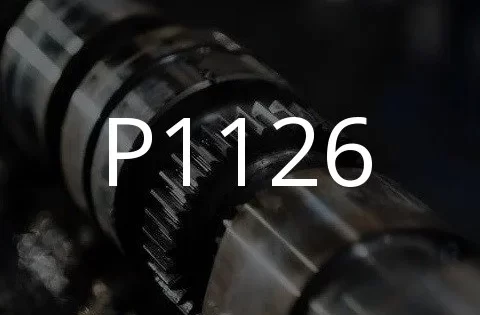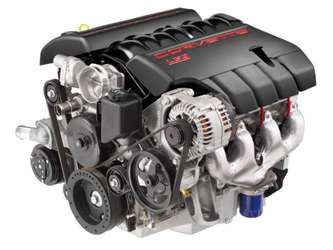
P1126 (Volkswagen, Audi, Skoda, Seat) Long-term fuel control system, bank 2, mixture too lean
Content
P1126 – OBD-II Trouble Code Technical Description
Fault code P1126 indicates that the fuel-air mixture in engine block 2 is too lean in Volkswagen, Audi, Skoda, and Seat vehicles.
What does the fault code mean P1126?
Trouble code P1126 indicates a problem with the air/fuel mixture in the engine system, bank 2. This code indicates that the long-term fuel trim system detects that the mixture is too lean, meaning it contains too much air relative to the fuel. This can result in inefficient fuel combustion, which in turn can cause problems with engine performance, poor fuel economy and emissions.

Possible reasons
Several possible causes for the P1126 trouble code:
- Fuel system problems: Faulty fuel injectors can result in under-injection of fuel, leaving the mixture lean. Also, a clogged or malfunctioning fuel filter can reduce fuel pressure, which can also lead to a lean mixture.
- Problems with sensors: A malfunctioning Mass Air Flow (MAF) sensor can cause the amount of air entering to be incorrectly measured, resulting in a too lean mixture. Also, a faulty oxygen (O2) sensor can give incorrect signals to the engine controller, which can also cause fuel mixture problems.
- Problems with the intake system: Air leaks in the intake system can cause extra air to enter, causing the mixture to lean.
- Problems with the ignition system: A malfunctioning ignition system, such as faulty spark plugs or problems with the ignition coils, can also cause fuel to burn incorrectly, resulting in a too lean mixture.
Diagnosing these problems may require the use of specialized equipment to scan and analyze engine parameters.
What are the symptoms of a fault code? P1126?
Some possible symptoms for trouble code P1126:
- Power Loss: If the fuel/air mixture is too lean, the engine may experience a loss of power when accelerating or idling.
- Unstable engine operation: A lean mixture can cause the engine to run rough, especially when idling or at low speeds.
- Podtormaživanie: The engine may hesitate or jerk at low speeds or under variable load.
- Unstable XXX: With a lean mixture, the engine may run unstable at XXX, and may even stall after starting.
- Deterioration in fuel economy: Because the mixture is lean, an increase in fuel consumption may occur as the engine may consume more fuel to maintain normal operation.
- Errors in the engine control system: If P1126 is present, other trouble codes may also occur related to the air/fuel mixture balance or sensor malfunctions.
How to diagnose a fault code P1126?
For DTC P1126, the following diagnostic steps are recommended:
- Check errors with an OBD-II scanner: Use a diagnostic scanner to check for other trouble codes. This will help determine if there are other problems that may be related to the air/fuel mixture being balanced.
- Check for vacuum leaks: Check vacuum hoses and components for leaks that could cause the air/fuel mixture to become unbalanced.
- Check the mass air flow (MAF) sensor: The MAF sensor measures the amount of air entering the engine. If it gives incorrect data, it can lead to an imbalance in the mixture. Check it for dirt or damage, and check its operation using a data scanner.
- Check oxygen sensor (O2): The oxygen sensor monitors the oxygen level in the exhaust gases and helps regulate the fuel/air mixture. Check it for damage or wear.
- Check fuel pressure: Low fuel pressure can cause a lean mixture. Check the fuel pressure using an appropriate tool and make sure it meets the manufacturer's specifications.
- Check the injectors: Clogged or malfunctioning fuel injectors can cause fuel to spray unevenly, resulting in a lean mixture. Check the injectors for blockages or damage.
- Check the electrical connections: Perform a visual inspection and check the electrical connections associated with the oxygen sensor heater and other sensors to ensure they are securely connected and not damaged.
After completing these steps, you can determine the cause and resolve the problem that is causing the P1126 code. If you are not confident in your skills, it is better to contact a qualified mechanic or car service for more accurate diagnosis and repair.
Diagnostic errors
When diagnosing DTC P1126, the following errors may occur:
- Ignoring other problems: Trouble code P1126 indicates that the air/fuel mixture is too lean. However, sometimes a mechanic may focus solely on this problem, without paying attention to other potential causes, such as vacuum leaks, faulty mass air flow sensor or fuel injectors.
- Faulty sensor diagnostics: Poor diagnosis of sensors such as the mass air flow sensor or oxygen sensor can lead to incorrect conclusions about the condition of the fuel injection system.
- Insufficient component check: It is not always obvious which component is causing the air/fuel mixture to be too lean. Some mechanics may skip checking fuel pressure, injector condition, or electrical connections, which can lead to an incorrect diagnosis.
- Faulty data interpretation: Understanding the data obtained from diagnostic tools requires experience and knowledge. Incorrect interpretation of this data may lead to incorrect conclusions about the cause of the malfunction.
- Insufficient checking for vacuum leaks: Vacuum leaks can cause the mixture to run too lean, but finding them requires careful inspection, which may be missed.
To successfully diagnose and resolve trouble code P1126, it is important to have experience and knowledge in the field of automotive repair, as well as the use of appropriate diagnostic equipment.
How serious is the fault code? P1126?
Trouble code P1126 indicates that the fuel/air mixture in block 2 of the engine is too lean. While this can result in inefficient combustion and possible vehicle problems, in most cases it is not a critical issue that will immediately cause the vehicle to not be driven.
However, this may result in poor fuel economy, reduced engine power and increased emissions. Therefore, you should not ignore this trouble code, especially if it appears regularly or is accompanied by other symptoms such as poor engine operation or poor performance.
If code P1126 appears on your vehicle's display, it is recommended that you have the problem diagnosed and repaired by a qualified mechanic.
What repair will help eliminate the code? P1126?
Trouble code P1126 may require a number of steps to resolve:
- Checking the fuel system: Check the condition of the fuel injectors, fuel pump and fuel filter. Replace or clean faulty components.
- Checking the air injection system: Check the mass air flow (MAF) sensor, manifold absolute pressure (MAP) sensor and boost pressure sensor (BOOST) for malfunctions.
- Checking the ignition system: Check the condition of the spark plugs and ignition coils. Replace them if necessary.
- Checking the exhaust system: Check the condition of the catalyst and oxygen (O2) sensors. Clean or replace them if they are damaged.
- Checking electrical connections: Check the wires and connectors related to the fuel injection system and air intake system. Eliminate short circuits or broken wires.
- Updating the software: In some cases, the engine control unit (ECU) software may need to be updated to resolve the issue.
It is important to note that to successfully resolve P1126, it is recommended that you have a qualified mechanic or authorized service center diagnose and perform any necessary repairs.

